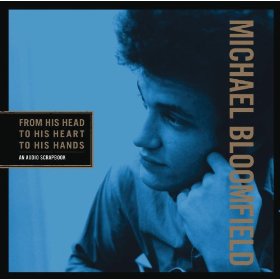
Legacy Recordings
The late guitarist Michael Bloomfield’s name routinely appears on “best of” lists; the fact is, his musical legacy has never been served up in a proper collection – until now. And it took another musical legend to it.
Al Kooper first crossed paths with Michael Bloomfield during Bob Dylan’s Highway 61 sessions: Kooper was on hand to play guitar; however, when Bloomfield strapped on his Telecaster and fired off a few warm-up licks, Kooper quickly moved to a berth behind the Hammond B3 (which he’d never played before). Not only was history made during those sessions, but a friendship forged. Bloomfield and Kooper collaborated both in the studio (including the well-known Super Session album) and on stage in various settings over the years leading up to Bloomfield’s death in 1981.
From His Head To His Heart To His Hands is a 3-CD/single DVD box set, produced by Kooper. The music is laid out basically chronologically, spread over three discs simply titled “Roots”, “Jams” and “Last Licks”. The accompanying 40-page booklet contains wonderful photos and extensive liner notes; the music, however does the real telling of the tale. It’s clear that the right man was at the helm.
One of the points the box set makes along the way is how Bloomfield often pulled the players in his immediate vicinity into his orbit when he made music, pushing them to go further. The studio version of The Paul Butterfield Blues Band’s “East-West” is a classic example of that – a piece that will forever blow the mind of anyone hearing it for the first time, backed by the double whammy of realizing it was recorded in 1966.
Get your head around that, folks: 1966. The Dead were just beginning to explore the far reaches of their own inner space at that point; and in the years to follow, the Allman Brothers would see how far they could take things with pieces such as “Mountain Jam”. But when the Butterfield band tore into this 13-minute-plus Chicago-blues-meets-modal-Miles-meets-acid-fueled-raga, there wasn’t a template to follow … just Bloomfield’s post-trip epiphany that he’d unlocked the door to Indian music in his mind (and thus in his heart and with his hands). Elvin Bishop is the perfect wingman for Bloomfield in this performance, providing the “West” anchor with some cool rhythm work and fierce-yet-tasteful soloing of his own; when Butterfield makes his entrance at the 1:27 mark, you’d swear it was Coltrane blasting out of the center of the earth; and Bloomfield proves that he had not only blazed that Far East route in his musical mind, but figured out how to hot-wire a flying carpet while he was there. And made room for the whole band to ride along as well.
Kooper works some production magic throughout the collection’s three discs – never to offer a false image of what went down at the time; only to sharpen and clarify the view. For instance, Dylan’s “Like A Rolling Stone” is presented here as an instrumental, allowing every one of Bloomfield’s fills and punctuations to be heard – in a remix that accentuates Bobby Gregg’s drums and Paul Griffin’s often-overlooked piano. The result showcases the brilliance of all hands involved. And a collage of two live versions of “59th Street Bridge Song (Feeling Groovy)” – the Fillmores East and West in 1968 – is relatively seamless, the power of Bloomfield and Kooper jamming together obliterating whatever sonic irregularities exist.
Kooper was a great choice to put this collection together: he was a friend and musical brother to Bloomfield, inspiring some of his finest playing. Witness the free-ranging melodic spirals of “His Moly Modal Majesty” (an outtake from the original Super Session release), “Her Holy Modal Highness” (from Bloomfield and Kooper’s Live Adventures album) and the unique spins on such well-known classics as “One Way Out” and “The Weight”. The duo worked up numerous tributes to their heroes during their collaborations – both original numbers (such as the previously unreleased “Santana Clause” from the Fillmore East in 1968) and covers (including Ray Charles’ “Mary Ann” and Arthur Crudup’s “That’s All Right”, both featuring vocals by Bloomfield).
There’s solo Mike Bloomfield: just the man and his guitar (the acoustic “Dark Town Strutters Ball”, and “I’m Glad I’m Jewish”); with minimal backing (three numbers from Bloomfield’s audition for John Hammond Sr. at Columbia Records in 1964 are included with Bill Lee on bass); and some full band numbers from early on (“I’ve Got You In The Palm Of My Hand” and “I’ve Got My Mojo Workin’” with Bloomfield leading the way on guitar and vocals).
And there are wonderful examples of Michael’s times as “one of the band” when his talent is never showboated, but can’t help but shine. Besides the aforementioned “East-West”, the Butterfield band’s propensity to venture beyond the blues is well-demonstrated while The Electric Flag used horns, Buddy Miles’ powerhouse drumming, Nick Gravenites’ real-thing bluesman vox, and Bloomfield’s out-there approach to forge their own sound (dig the previously-unreleased “Susie’s Shuffle” from the Carousel Ballroom in 1968).
Mike Bloomfield played alongside blues gods (he sits in with Muddy Waters for “Can’t Lose What You Ain’t Never Had”) and rock ‘n’ roll queens (a session from Janis Joplin’s “I’ve Got Them Ol’ Kozmic Blues Again Mama!” is included), but his work with Bob Dylan might just be the go-to material if one needed to pick a couple tracks for a time capsule. Two of the previously unreleased tracks that Kooper unearthed for the From His Head To His Heart To His Hands box nicely bookend Bloomfield’s musical legacy. The first is from the Highway 61 sessions: a raucous version of version of “Tombstone Blues” featuring the Chambers Brothers (of “Time Has Come Today” fame) on background vocals. Bloomfield’s lead work is fiery, fierce, and unflinching – almost bordering on reckless, but never missing a lick. He manages the cool feat of laying down a near-constant barrage of raw guitar while staying out of the way of Dylan’s lead vocals – he shines a light on them, if anything. The second example was captured live just a few months before Bloomfield’s death: Dylan invited him to sit in during a performance at the Warfield Theater in San Francisco in November of 1980. Bloomfield was hesitant, deciding to accept Dylan’s invitation at the last moment. He might have shuffled onstage in his slippers that night, but Michael Bloomfield demonstrated he still possessed a natural magic that could be summoned at will … when he had the will to do so. (Kooper tastefully follows the Dylan sit-in with the lovely “Hymn Time” – just Bloomfield and an acoustic guitar.)
Sadly, San Francisco was also where Michael Bloomfield drew his last breath. His body was found slumped behind the wheel of a car on a side street in San Francisco on February 15, 1981. The doors were locked and the keys were in the ignition; his system was loaded with cocaine – a drug he never liked; and there were so, so many questions that never got answered. Though family and friends could make no sense of Michael Bloomfield’s death, the authorities pronounced it a cut-and-dried case of another dead doper musician – and basically left it at that.
Any collection such as this runs the risk of omitting material that some may deem critical, or leaning too heavily toward one period or another of an artist’s career. It couldn’t have been an easy task for Al Kooper to assemble From His Head To His Heart To His Hands, but luckily for us he did, investing a year in the doing of it. The fourth disc included in the box is Bob Sarles’ “Sweet Blues” – a well-done documentary of Bloomfield’s life. The combination of that with three CDs-worth of music truly lives up to Kooper’s vision of an “audio/visual scrapbook.”
Listeners who weren’t already familiar with Bloomfield’s music will be amazed; hardcore fans will find plenty of rare and unreleased material to burrow into as well – and will enjoy Kooper’s mixes and sequencing of the familiar material.
The result is not only a fine tribute from one master musician to another – it’s a memorial to a friend.
*****
Brian Robbins shuffles around in his slippers over at www.brian-robbins.com



No Comments comments associated with this post